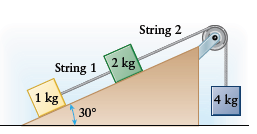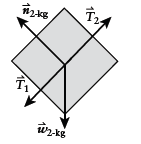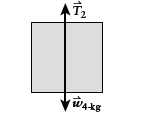
Concept explainers
The acceleration of the masses and tension in the strings.
Answer to Problem 101QAP
Tension in String
Tension in String
acceleration of the masses
Explanation of Solution
Givendata:
Mass of block A,
Mass of block B,
Mass of block B,
Formula Used:
Newton's second law:
Calculation:
For theblocks on the ramp, we can use a coordinate system wherethe axes are parallel and perpendicular to the face of theramp and up the ramp is considered positive.
For the
All three blocks have the sameacceleration because they are joined together.
Using Newton's second law for each of theblocks, we can solve for the acceleration in terms of the known masses.
Once we calculate theacceleration, we can calculate the magnitudes of the tensions.

Free-body diagram of

Free-body diagram of

Free-body diagram of

Newton's second law:
Solving for the acceleration:
Solving for the tensions:
Conclusion:
Thus, we havethe acceleration of the masses and tension in the strings as below: -
Tension in String
Tension in String
acceleration of the masses
Want to see more full solutions like this?
Chapter 4 Solutions
COLLEGE PHYSICS
- A 5.00-kg block is placed on top of a 10.0-kg block (Fig. P5.50). A horizontal force of 45.0 N is applied to the 10-kg block, and the 5-kg block is tied to the wall. The coefficient of kinetic friction between all moving surfaces is 0.200. (a) Draw a free-body diagram for each block and identify the action-reaction forces between the blocks. (b) Determine the tension in the string and the magnitude of the acceleration of the 10-kg block. Figure P5.50arrow_forwardAs a fish jumps vertically out of the water, assume that only two significant forces act on it: an upward force F exerted by the tail fin and the downward force due to gravity. A record Chinook salmon has a length of 1.50 m and a mass of 61.0 kg. If this fish is moving upward at 3.00 m/s as its head first breaks the surface and has an upward speed of 6.00 m/s after two-thirds of its length has left the surface, assume constant acceleration and determine (a) the salmons acceleration and (b) the magnitude of the force F during this interval.arrow_forwardAs a fish jumps vertically out of the water, assume that only two significant forces act on it: an upward force F exerted by the tail fin and the downward force due to gravity. A record Chinook salmon has a length of 1.50 m and a mass of 61.0 kg. If this fish is moving upward at 3.00 m/s as its head first breaks the surface and has an upward speed of 6.00 m/s after two-thirds of its length has left the surface, assume constant acceleration and determine (a) the salmon’s acceleration and (b) the magnitude of the force F during this interval.arrow_forward
- An object experiences a net zero external unbalanced force. Is it possible for the object to be travelling with a non-zero velocity? If yes,then state an example.arrow_forwardas a fish jump vertically out of the water, assume that only two significant forces act on it: an upward force F exerted by the tail fin and the downward force due to gravity. a force chinook salmon has a length of 1.50 m and a mass of 48.5 kg. if the fish is moving upward at 3.00 m/s as its head first breaks the surface and has an upward speed of 5.80 m/s after two-thirds of its length has left the surface, assume constant acceleration and determine the following. a. the salmon's acceleration b. the magnitude of the force F during this intervalarrow_forwardIn 1991, a lobster with a mass of 20.0 kg was caught off the coast of Nova Scotia, Canada.Imagine this lobster involved in a friendly tug of war with several smaller lobsters on ahorizontal plane at the bottom of the sea. Suppose the smaller lobsters are able to drag thelarge lobster, so that after the large lobster has been moved 1.55 m its speed is 0.550 m/s. Ifthe lobster is initially at rest, what is the magnitude of the net force applied to it by thesmaller lobsters? Assume that friction and resistance due to moving through water arenegligiblearrow_forward
- Only one force acts on an object. Can the object have zero acceleration? Can it have zero velocity? Explain you answer in words.arrow_forwardA 27.0-kg block is initially at rest on a horizontal surface. A horizontal force of 74.0 N is required to set the block in motion, after which a horizontal force of 61.0 N is required to keep the block moving with constant speed. (a) Find the coefficient of static friction between the block and the surface.(b) Find the coefficient of kinetic friction between the block and the surface.arrow_forward10. The two blocks are attached to each other by a massless string that is wrapped around a frictionless pulley. When the bottom 9.00-kg block is pulled to the left by the constant force P. The top 6.00-kg block slides across it to the right. Find the magnitude of the force necessary to move the blocks at constant speed. Assume that the coefficient of kinetic friction between all surfaces is 0.700.arrow_forward
- Newton's second law states F = ma. Which of the following scenarios must be true? A. You lift upward on a tree branch, and it accelerates upward. B. When struck with the same amount of force, a hollow ping pong ball has a larger acceleration than a solid golf ball of the same size. C. When the mass of soil in a wheelbarrow is doubled, the force must be doubled to maintain the same acceleration. D. You push to the left on a desk while friction pushes to the right, so that the desk doesn't accelerate. E. A greater force is required to take a tractor-trailer from 0 to 60 mph than is required to take a motorcycle from 0 to 60 mph in the same amount of time.arrow_forward25- A Hospital bed requires a frictional force Fr to keep it moving with constant velocity across a floor. If the coefficient of friction is μ, then the normal force N is given by: A.μ /Fr B.μ Fr C.Fr /μ D.Fr E.μarrow_forward
 College PhysicsPhysicsISBN:9781285737027Author:Raymond A. Serway, Chris VuillePublisher:Cengage Learning
College PhysicsPhysicsISBN:9781285737027Author:Raymond A. Serway, Chris VuillePublisher:Cengage Learning College PhysicsPhysicsISBN:9781305952300Author:Raymond A. Serway, Chris VuillePublisher:Cengage Learning
College PhysicsPhysicsISBN:9781305952300Author:Raymond A. Serway, Chris VuillePublisher:Cengage Learning Principles of Physics: A Calculus-Based TextPhysicsISBN:9781133104261Author:Raymond A. Serway, John W. JewettPublisher:Cengage Learning
Principles of Physics: A Calculus-Based TextPhysicsISBN:9781133104261Author:Raymond A. Serway, John W. JewettPublisher:Cengage Learning College PhysicsPhysicsISBN:9781938168000Author:Paul Peter Urone, Roger HinrichsPublisher:OpenStax College
College PhysicsPhysicsISBN:9781938168000Author:Paul Peter Urone, Roger HinrichsPublisher:OpenStax College



